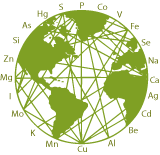Samarium- Function and Use
Samarium has no biological role; some samarium salts are slightly toxic.
Samarium salts stimulate metabolism, but it is unclear whether this is from samarium or other lanthanides present with it. Samarium is not absorbed by plants to a measurable concentration and so is normally not part of human diet. However, a few plants and vegetables may contain up to 1 part per million of samarium. Insoluble salts of samarium are non-toxic and the soluble ones are only slightly toxic. When ingested, only 0.05% of samarium salts are absorbed into the bloodstream and the remainder are excreted. From the blood, 45% goes to the liver and 45% is deposited on the surface of the bones where it remains for 10 years; the remaining 10% is excreted.
The radioisotope samarium-153 is the active component of the drug samarium lexidronam (Quadramet), which kills cancer cells in lung cancer, prostate cancer, breast cancer and osteosarcoma.
Samarium is used in alcohol reagents, lasers, and in the tinting of special infrared absorbing glass. It also is used as a neutron absorber in nuclear reactors, infrared equipment, headphones and miniature speakers, catalysts, ceramics, carbon arc lamps, and electronics. Other uses of samarium include catalysis of chemical reactions, radioactive dating and X-ray lasers. Samarium(II) iodide, in particular, is a common reducing agent in chemical synthesis. The main commercial use of samarium is in samarium–cobalt magnets. Another isotope, samarium-149, is a strong neutron absorber and so is added to control rods of nuclear reactors.
Ref:
- Emsley, John (2001). "Samarium". Nature's Building Blocks: An A–Z Guide to the Elements. Oxford, England, UK: Oxford University Press. pp. 371–374
- Human Health Fact Sheet on Samarium Archived 2012-04-07 at the Wayback Machine, Los Alamos National Laboratory
- Bayouth, J. E.; Macey, D. J.; Kasi, L. P.; Fossella, F. V. (1994). "Dosimetry and toxicity of samarium-153-EDTMP administered for bone pain due to skeletal metastases". Journal of Nuclear Medicine. 35 (1): 63–69. PMID 7505819.
